The extraordinary mosaic floor discovered in the remains of a 4th century Roman villa in Boxford, West Berkshire, two years ago has been revealed in all its glory.
The edge of the pavement was first discovered around 1870 when a land drain was installed that cut through the wall and the border of the mosaic. Documentation of the find was cursory at best, with vague references to the location of the site, known as Mud Hole for its propensity towards waterlogging (hence the need for a land drain) and does not record the existence of a mosaic. The Victorian excavation can’t have been a thorough one as the team has found no evidence of it since explorations of the site began in 2011.
Geophysical surveys and excavations of three potential Roman sites within a mile of Boxford progressively revealed the remains of a large villa, a detached bath house with hypocaust heating, a warm room and a cold plunge pool, and a barn at one of the sites, Hoar Hill. Pottery and coins found at the site dated the large villa and farm to the 3rd and 4th centuries, with significant modifications and expansions during its lifespan and some evidence of even earlier occupation. Fragments of painted wall plaster pointed to this having been a fashionable, expensively decorated domus, unusually so considering its rural setting in a backwater province of the empire.
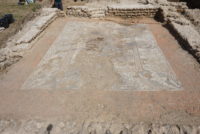 The Mud Hole villa, on the other hand, was modest in size with a simple layout. Instead of a bathhouse, it has a small bath suite on the northwest end. It dates to around 380 A.D., a time when Roman control of Britain was rapidly waning, and given its dimensions, archaeologists had no reason to expect the kind of handsome furnishings they’d seen glimpses of in the Hoar Hill villa.
The Mud Hole villa, on the other hand, was modest in size with a simple layout. Instead of a bathhouse, it has a small bath suite on the northwest end. It dates to around 380 A.D., a time when Roman control of Britain was rapidly waning, and given its dimensions, archaeologists had no reason to expect the kind of handsome furnishings they’d seen glimpses of in the Hoar Hill villa.
When a trench was dug on the southeast end of the structure, red tesserae were unearthed just beneath the ploughsoil level. The red tiles proved to be the exterior border of a far more complex mosaic floor. It had been preserved despite centuries of agricultural work on the property, because it was in a terraced position steps down from the main farm work and because the collapse of the building had covered the pavement in protective rubble.
The first section of the mosaic, a strip twenty feet long and 6.5 feet wide, was discovered in August of 2017 by a team of community volunteers and professional archaeologists overseen by Cotswold Archaeology. They worked from morning to night to uncover and clean the strip within the short time remaining (the entire dig season only lasts two weeks).
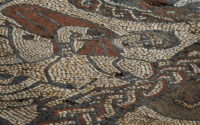 Mosaic experts were called in to examine the find. They identified scenes from Greek mythology that indicated the owner of the villa was keen to display his grasp of Roman culture. The section included a portion of the central panel depicting the hero Bellerophon on the winged horse Pegasus defeating the Chimera. The border featured another scene from mythology — Hercules fighting the centaur Nessus — plus a roundel with a figure holding a wreath, a kantharos drinking cup, floral elements and in each of the two exposed corners a telamon, muscular heroes named after the Argonaut and father of Ajax that often decorated weight-bearing structures in Greek and Roman architecture (known as atlantes after the titan Atlas in Greek). The telamons jutted out of their roundels, their strong arms holding up the corner of the central panel.
Mosaic experts were called in to examine the find. They identified scenes from Greek mythology that indicated the owner of the villa was keen to display his grasp of Roman culture. The section included a portion of the central panel depicting the hero Bellerophon on the winged horse Pegasus defeating the Chimera. The border featured another scene from mythology — Hercules fighting the centaur Nessus — plus a roundel with a figure holding a wreath, a kantharos drinking cup, floral elements and in each of the two exposed corners a telamon, muscular heroes named after the Argonaut and father of Ajax that often decorated weight-bearing structures in Greek and Roman architecture (known as atlantes after the titan Atlas in Greek). The telamons jutted out of their roundels, their strong arms holding up the corner of the central panel.
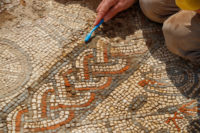 Less than half of the mosaic was unearthed in 2017. The mosaic was reburied for its own protection, as that was the last planned season of the Boxford excavation. The Boxford History Project set about raising funds for a full four week excavation that would reveal the remaining mosaic as well as the floor plan of the villa. Thanks to contributions from the public and sponsors, on August 19th, 2019, the team of volunteers and professional returned to Mud Hole. On the first day they found more of the red border. By the 27th, they had uncovered the whole thing, wall to wall. The floor was washed and ready to be shown to the public on August 31st. About 3,000 people came to the Open Day to see this unique work.
Less than half of the mosaic was unearthed in 2017. The mosaic was reburied for its own protection, as that was the last planned season of the Boxford excavation. The Boxford History Project set about raising funds for a full four week excavation that would reveal the remaining mosaic as well as the floor plan of the villa. Thanks to contributions from the public and sponsors, on August 19th, 2019, the team of volunteers and professional returned to Mud Hole. On the first day they found more of the red border. By the 27th, they had uncovered the whole thing, wall to wall. The floor was washed and ready to be shown to the public on August 31st. About 3,000 people came to the Open Day to see this unique work.
Anthony Beeson, the classical art expert who in 2017 had helped identify the Bellerophon motif and described the find as “without question the most exciting mosaic discovery made in Britain in the last fifty years,” gave visitors a guided tour of the full mosaic. It turns out that the Bellerophon scenes were only around the edge of the central panel. The main subject was the story of Pelops who won his bride by fixing a chariot race. The key to his trickery — a single lynch pin — was also the key to Beeson recognizing the mythological tale being depicted.
Explaining the story depicted in the mosaic, Mr Beeson said: “The pavement shows Bellerophon and Pegasus but the main action is the story of Pelops and his race to win the hand of the Princess Hippodamia.
“The king, Oenomaus, having been told that his future son-in-law would bring about his death, made all contestants race him in a chariot but handicapped them by putting the princess in the vehicle with them.
“The losers were decapitated and their heads displayed.
“Pelops persuaded a former lover Myrtilus and the King’s chariot master to substitute a wax lynch pin and the king was killed when the wheels flew off.
“Pelops thereby won but killed Myrtilus who cursed his lineage and brought about the curse of the Pelops. The king’s funerary games are said to be the origin of the Olympics.”
The mosaic has been reburied and there are no current plans for its display. It will not be raised. The fields around it will continue to be farmed, so it’s not likely that it can be exhibited in situ either, at least not full-time.
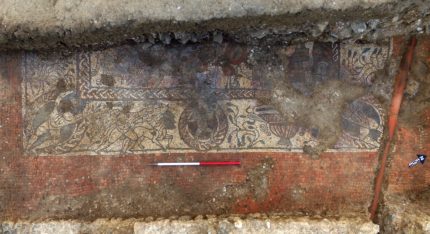
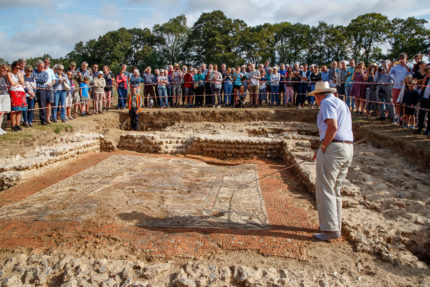
I’m so happy to read this given I grew up and have family within a couple of miles of the site. The area is very rural but I’ve always known a couple of major but now lost Roman Roads threaded through. And I’m so pleased to hear that the find will be re-buried and not ripped up. Leave it where it is. Leave it in the soil where it has been. Fascinating story
One of the great things about a mosaic is they move with the shifting ground, and can end up looking like a carpet laid on uneven ground.